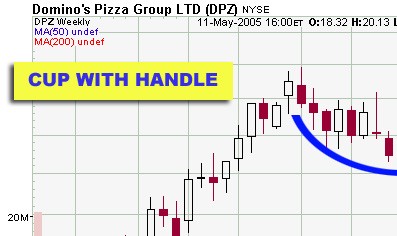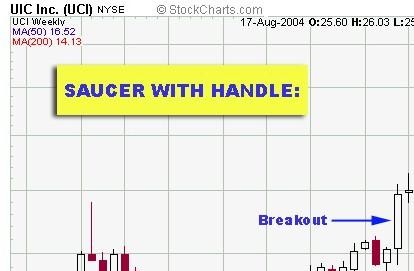The basis of this article stems from the teachings of William O’Neil and his CANSLIM acronym.
Stocks breakout from properly formed bases everyday but many investors don’t understand how to locate a pivot point or what patterns to study that may contain this very important buy signal. A pivot point can be described as the optimal buy point or the area at the end of a familiar base pattern where the stock breaks out into new high territory. William O’Neil, the founder of Investor’s Business Daily is considered the pioneer of the pivot point in modern times. As Jesse Livermore explains in his book (1941), the pivot point can also be described as the point of least resistance. When a stock breaks the point of least resistance, we are presented with an opportunity where a stock has the greatest chance of moving higher in a short period of time, especially when volume accompanies the breakout.
The pivot point can be calculated as the stock is forming the handle on a cup-with-handle base. The ideal buy price would be $0.10 higher than the highest spot during the handle, also know as the top of the right side of the base. The intraday high can qualify at the highest point and does not have to be the closing price of the stock. If the stock closes at the high for the day, then we will use this number as the high point.
The exact methods used for finding pivot points vary depending on the base pattern that is forming on a daily and/or weekly chart.
When a flat base occurs, an investor should look for a move $0.10 higher than the top point on the left side of the base or the start of the formation.
A saucer-with-handle follows the same rules as the cup-with-handle and is described in detail above.
A double-bottom formation triggers a pivot point that will be $0.10 higher than the middle peak in the “W” shaped pattern.
Many investors will try to cheat the rules and place a position prematurely before the stock breaks out and passes the pivot point. I do not suggest buying until the stock triggers the pivot point on above average volume also known as qualifying volume. The area considered as the least amount of resistance is weighed so heavily because all overhead sellers are gone as we break into new high territory. The pivot point usually comes within 5% to 15% of the stock’s old high 52-week high.
Don’t chase a stock that is 5% or more above the proper pivot point. This does not mean that you can’t buy on normal corrections and pullbacks to support or moving averages, especially if the stock remains in an uptrend. This rule only applies to the pivot point area as the stock becomes extended. If you buy with the pivot point and sell when a stock falls 5-10% from the pivot point, I guarantee that your yearly performance will increase dramatically. However, your risk must stay within 1-2% maximum of total portfolio value and risk-to-reward ratio should be at least 2.5:1.
How to Look for a Cup with Handle (chart #1):
Look for relatively quiet volume as the stock builds the left side of the cup. Volume at the base of the cup should be slightly higher than the left side as support is coming into the stock. The right side of the base should have above average volume with more up-days than down days. The handle will be the last part of the formation and should slope slightly downward with lower volume than the right side of the base. The pivot point will be slightly higher than the highest point of the right side of the base. All breakouts should occur on volume 100% greater than average daily volume although IBD does say that breakouts above 50% do qualify.
How to Look for a Saucer with Handle (chart #2):
Look for relatively quiet volume as the stock builds the left side of the saucer. A saucer looks similar to the cup-with-handle but the dip from the high to the low is smaller and usually longer in duration. Volume at the base of the saucer should be slightly higher than the left side as support is coming into the stock. At this point, the base may almost qualify as a flat base. The right side of the base should have above average volume with more up-days than down days but this does not have to be as prominent as the cup-with-handle. The handle will be the last part of the formation and should slope slightly downward with lower volume than the right side of the base. The pivot point will be slightly higher than the highest point of the right side of the base. All breakouts should occur on volume 100% greater than average daily volume.







Nice post! Thanks, AJ.
I’ll add this to favorites. what a great resource!!!
Chris,
What’s the appropriate timeframe for a cup or saucer with handle? Is this something you’ll see intra day, over a month, a quarter, what? Which one is optimal?
Seven weeks minimum is ideal for both patterns and this includes the handle formation which should form for at least 3-5 days.
Chris,
Since I found your blog, I have been reading your
posts and allways learn someting.
Thanks for the great job.
AS.